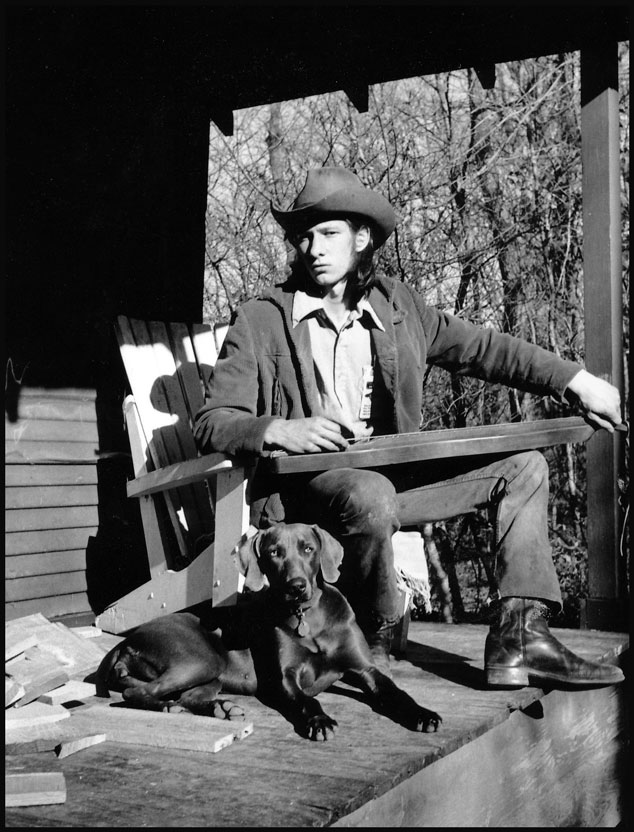
In 1972 I moved to Fayetteville from Shreveport to attend the University of Arkansas as a freshman. A friend of mine, Mimi Heinrichs, who had lived across the street from me in Shreveport, now lived with her boyfriend on Markham Hill in the small garage studio that had previously housed Ms. Markham’s Rolls Royce. Mimi frequently talked about the joys of living on the 150-acre property that was walking distance to campus. I was thrilled to be in the Ozarks. Having grown up in the flatlands of the Red River in northwest Louisiana, I was naturally intrigued by my friend’s descriptions of life on Markham Hill. I investigated the possibilities of rentals on the hill and as it turned out, there was a large cabin that was available.
My first home on the hill was in the red cabin that was on the north side of pasture. This was a much bigger structure than those in the woods on the south side of the field, which were all occupied by the typical counter-culture individuals of the time, otherwise known as hippies. It suited me well because I was an art major at the university and I was able to set up my easel in the cabin and work on paintings and wood sculptures. It was such an incredible joy to be able to walk down the hill to attend college and after classes walk back up the hill to my home on the edge of this wonderful field, surrounded by healthy forest. It was a much different lifestyle than Pomfret Dormitory, where I lived during my first semester at the university. Instead of being crowded in a noisy dorm, I had the freedom and quiet of open space. It was a big change and I loved it.
My only heat in the winter was from an old pot-bellied wood stove and a gas kitchen stove. The cabin had no insulation, so a good down sleeping bag was essential as well. The kitchen was fairly large, with a nice large country stove, so I got into cooking and had some good times entertaining friends around the dining table and hanging out on the front porch.
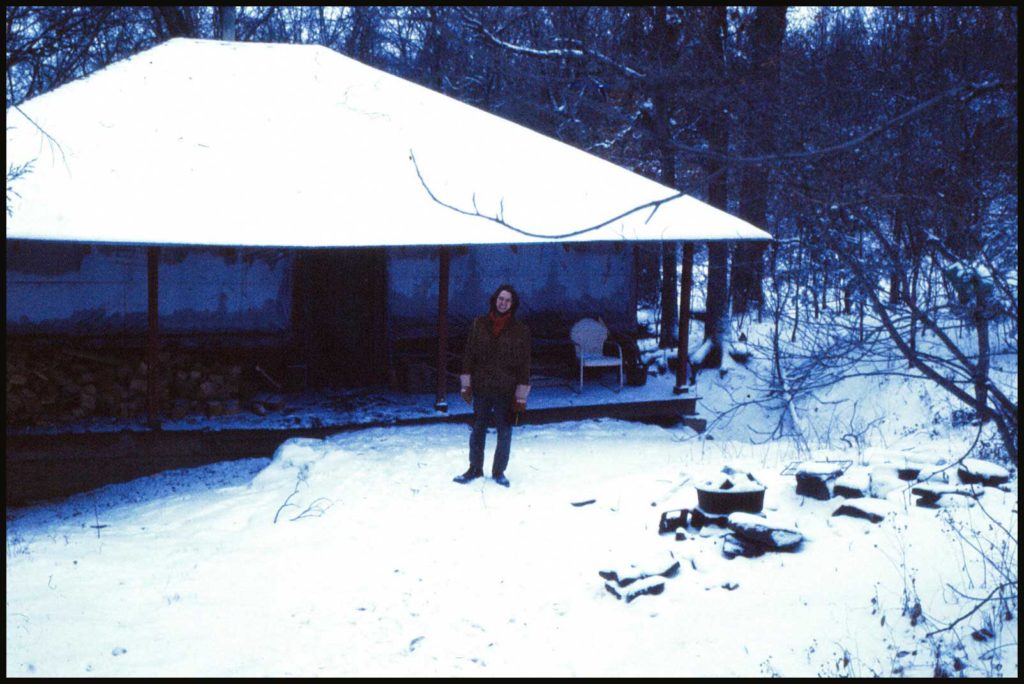
Up the hill from me, on the northeast side of the pasture, was another tiny little cabin tucked under a few trees. A guy named Jim Crow had fixed it up and lived there. Jim was a bluegrass picker and I think he went on to become a pretty well-known bluegrass musician. Anyway, Jim was frequently down on the porch playing his guitar and we had some good times jamming with other musically inclined friends who would stop in from time-to-time. I played the banjo and the mountain dulcimer.
Now that I had a place in the woods, I thought I’d get a dog. A classmate had some blue Weimaraner pups for sale and I got one and named him Blue. Blue was a skittish dog and it seemed like someone had mistreated him, even though he was just a few months old when I brought him home. For a few months Blue stayed close to the cabin or inside while I was away at school. One winter day when I got home, I opened the front door and feathers exploded as if a bomb had gone off. Inside, there were tiny goose down feathers everywhere. Blue had entirely chewed up the sleeping bag. He laid sheepishly on the floor of the cabin when the feathers cleared, knowing full-well he had done wrong, all covered in the evidence.
In those days, Ms. Markham kept lots of guinea hens, which stayed together in a large flock most of the time. One day Ms. Markham called me up to the house to talk with me about her guineas. She loved her birds, along with her daffodils, and was concerned that her flock was mysteriously shrinking. Her suspicion of course was that Blue was getting them. I assured her that Blue would never do such a thing and besides, he stayed down at the cabin most of the time. “Well” she said, “please keep an eye on him. I wouldn’t want to lose any more guineas.” By that time, I had become friends with Ms. Markham and would do little things for her around the property. I did not want to be responsible for my dog killing her birds, so I was a little more watchful of where Blue went when he set off sniffing through the woods. As time went on, more and more of Ms. Markham’s guineas disappeared and her flock was getting noticeably smaller. It was a mystery.
Around this time, I became friends with a hippie carpenter named Lucas Cook who was living in Ward Pennington’s old residence at the far end of the pasture. Lucas drove an old 1948 Chevy truck and although we were supposed to park our vehicles in the parking lot by Ms. Markham’s house and walk to our cabins, Lucas frequently paid little attention to this directive and frequently drove his truck across the pasture so he could have access to his tools when he was at home. Lucas was always doing some kind of work back on the old Pennington place and I often walked back there to visit and see what new project he was up to.
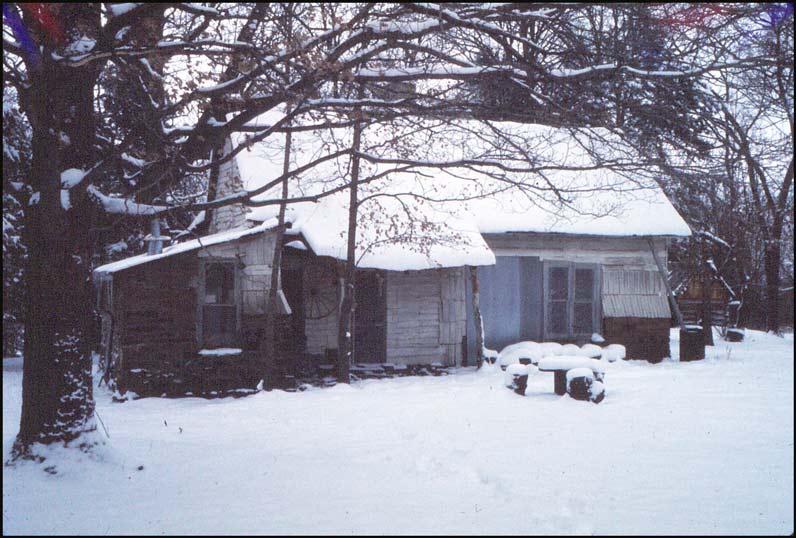
The old Pennington house when Lucas Cook lived there.
Across the yard from the ramshackle Pennington house were two old log buildings. One was a small log cabin with a hand-laid stone foundation and the other was an old log barn that hadn’t been used in many years. They were both filled with all kinds of trash and collections of old newspapers and magazines that Ward Pennington had squirreled away for years when he was alive. The old barn was covered with so much trash you couldn’t even tell it was built of logs except for one corner of the building where the log saddle notches were exposed.
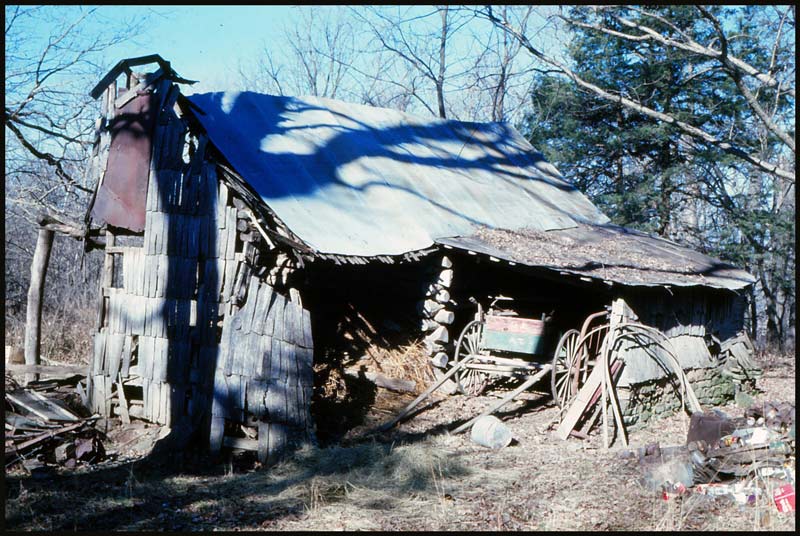
One day when I went to see Lucas, he was cleaning out the cabin that was built on the stonework. It was a small building, only about ten by fifteen feet or so, but it had a charming look to it and was situated under a beautiful cedar tree. Lucas had emptied the cabin and was busy building a sleeping loft inside. The place had a primitive flagstone floor and Lucas had put in a wood stove. I had never paid much attention to the place before, but now, with Lucas’ handiwork, it was rather charming. After seeing what he had done with this place, I wondered what might be next with the old log barn.
After making it livable, Lucas moved into the log cabin in the late fall, mainly because it was too hard to keep the old Pennington house warm in the winter. The tiny cabin made a fine place to visit and warm up around the wood-burning stove after the occasional snowfall that would transform the hill into a winter wonderland.

As winter progressed, Lucas started spending more time with his girlfriend who did not live on the hill. I was also learning about the difficulty of keeping my place warm with only a wood-burning stove. From what I remember, we had a lot of snow that winter and although it was beautiful, it was challenging. Getting up and down the hill on the ice-covered Markham Road was also stimulating, to say the least. I would frequently walk through snow to and from classes and even backpack my laundry to get that done.
In the spring, Lucas decided to move in with his girlfriend, away from Markham Hill. I immediately jumped at the chance to rent his little cabin. I had ideas about what could be done with the rest of the place and I liked the notion of living there. I thought I might live in the cabin for a while and eventually clean out and restore the old log barn that was behind the cabin.
These were busy days on the hill. It was around 1974 and people were always coming and going. All the cabins were occupied with interesting people and Ms. Markham seemed to delight in all the goings-on. She was in her bed most of time, becoming weaker and frail, but she would get daily reports from the people who lived there and was always interested in what was happening.
My friend Mimi and I both thought a community garden would be a good idea. We approached Ms. Markham with the proposal and she gave us permission to install the garden under the water tower. Apparently, when Ms. Markham had given the city permission to place the water tower on Markham Hill, the city had agreed to let Ms. Markham use all the water she wanted without cost. As a result, we could put in a large garden in the fenced area around the water tower and have all the water we needed, whenever we wanted it.
The garden started out with a half a dozen or so of the hill’s occupants pitching in to help. We planted a huge vegetable garden and mulched it with hay from the barn. The vegetables grew quickly with an abundance of water, but so did the weeds that sprouted from the hay we used. Later in the summer, after a few weeks in the heat and the prolific weeds, the garden volunteer squad got smaller and smaller. Pretty soon it was whittled down to just a couple of us. So much for community gardening. By mid-summer garden upkeep had become overwhelming – we had put in a much bigger garden than we could handle.
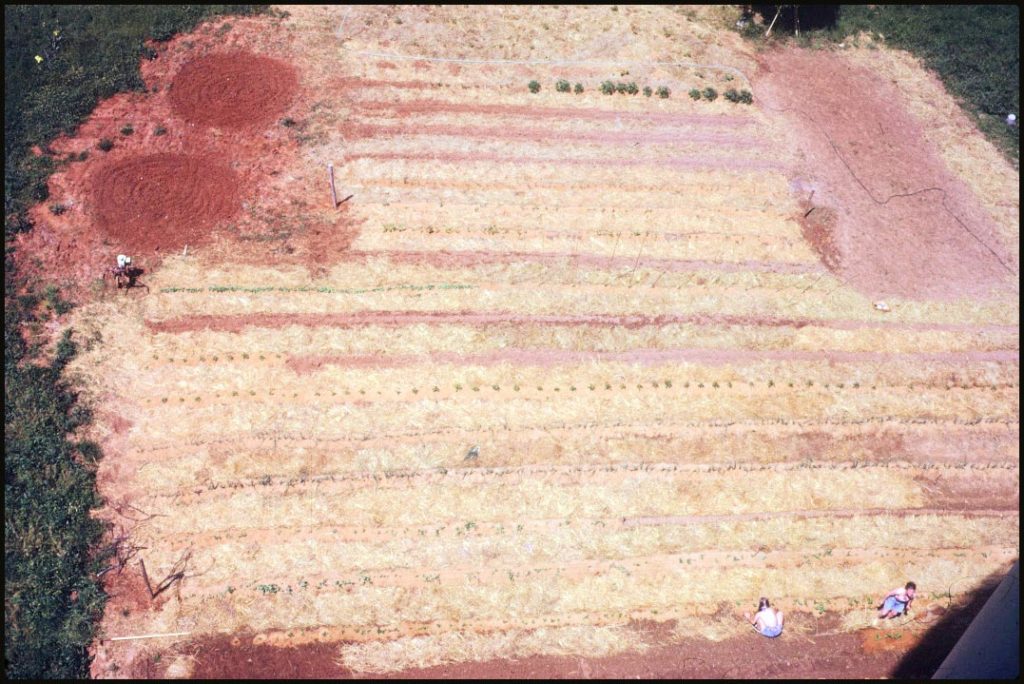
We ended up with a lot of squash and some tomatoes, but not much else. I suspect some of our early garden crew considered themselves entitled to partake in the harvest despite having dropped out of the effort involved to create it. That was the last and only time we put in a community garden.
I was busy working on my new homesite that summer as well. After Lucas moved out, the first thing I did was clean out all the trash inside and outside of the old log barn. I had an idea about fixing up the barn and turning it into a residence that would have a little more room than the cabin I was living in now.
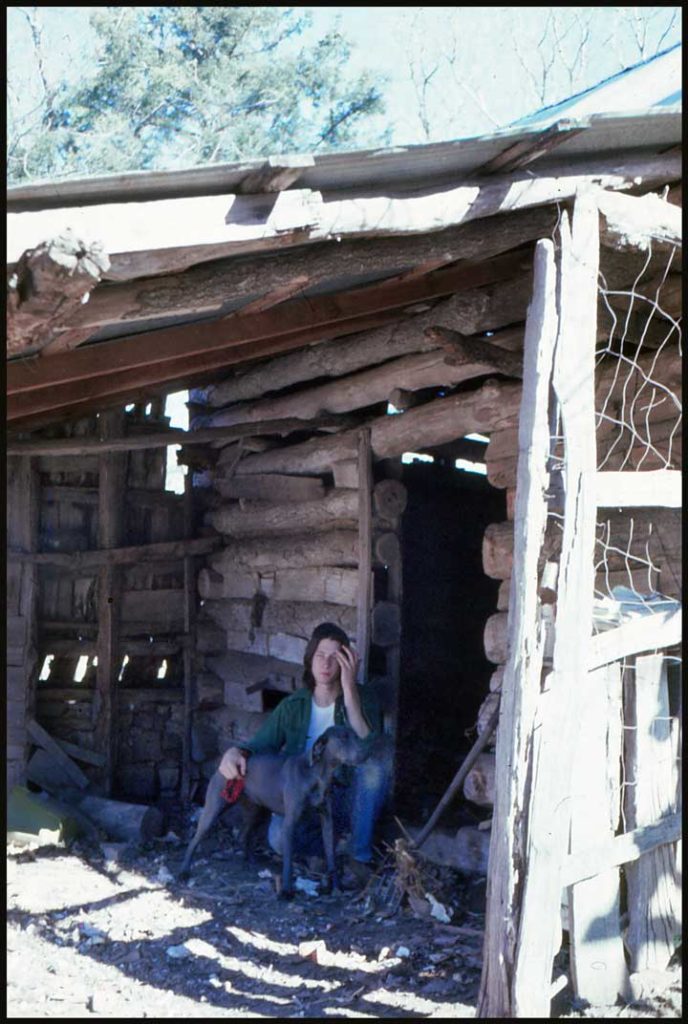
Cleaning away the debris outside was straightforward, but the inside was more of a problem. It was filled to the brim with tons of old magazines and newspapers. Ward Pennington was a hoarder and the inside of the old log barn was undoubtedly the mother lode of his collection. I spent days cleaning it out. I found many old rare magazines, many of which were in excellent condition having been buried for years in layers of various types of printed material. I still have some of the old magazines. I also found a photograph of Ward sitting on the top log beam when the barn was being built. There were three young women dressed in Sunday finery sitting up there as well. The photo was dated 1913. I’m sorry I don’t still have this remarkable old photo to show you. It was lost somewhere over the years.
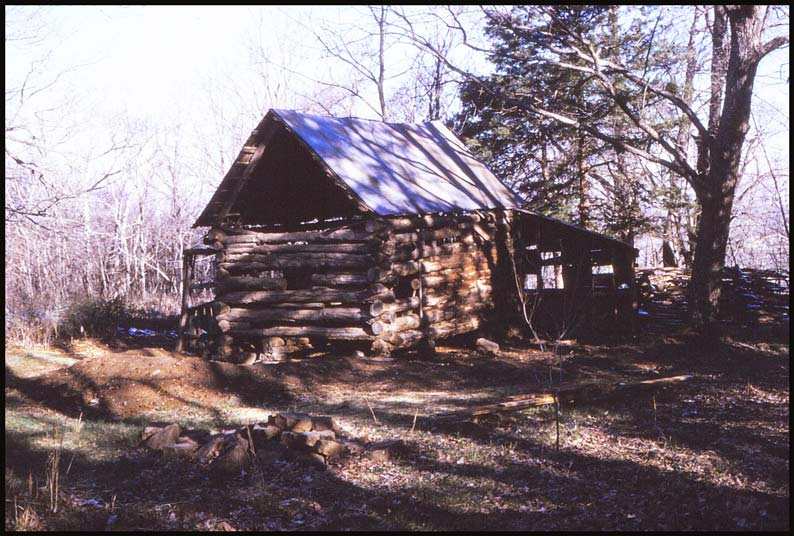
There were also plenty of rats and mice living in the trash inside the barn but I was determined to clear all the junk away and expose the handcrafted logs hidden beneath. I wore a pistol on my belt while I was cleaning to shoot rats that might have responded to their eviction aggressively. It was an unusual way for an art major to be spending time away from his studies, but I was having a great time imagining what the possibilites might be for the place. Like most of us on Markham Hill, I was very interested in getting “back to the land” and creating a lifestyle that was different from the middle class suburbia I’d grown up in. I had visions of not only restoring the barn, but also refurbishing the old wagon and horse-powered farm implements that I found in a dilapidated garden shed near the barn. I imagined getting a “Missouri mule” and keeping it in Ms. Markham’s pasture so that I could hitch up the old wagon and drive down to the food co-op near Dickson Street to get the weekly supplies of staples for the homestead. Needless to say, I was not quite living the typical college student routine.
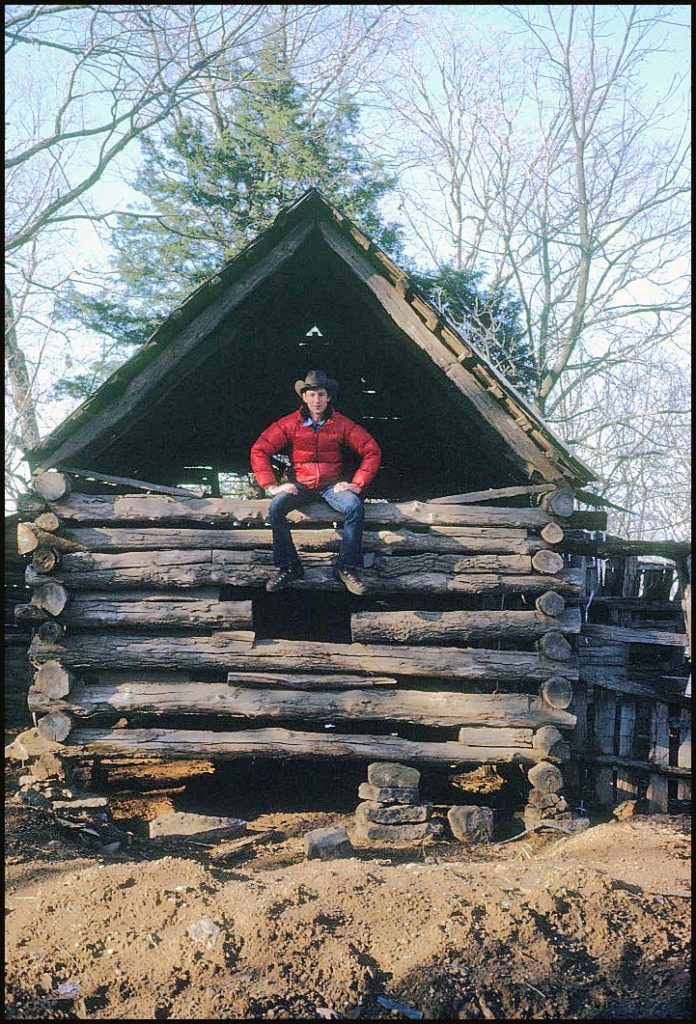
I was still living in the large red cabin down the hill while I worked on cleaning out the log barn. Most of the time my dog Blue would be with me, but one day, when I got down to the red cabin, I caught him with a dead guinea in his mouth. Ms. Markham’s guinea flock by that time had been reduced to a much smaller number and now I indeed knew why. I’d been told that once a bird dog gets the taste of killing, there’s only one way to stop them from it and that’s by attaching the dead bird around its neck and letting the carcass stay there until it rots. However, I didn’t have the heart to do that to Blue. Either Blue would have to leave the hill, or I would. I ended up giving Blue to a girl from one of my art classes who assured me she would love him and give him a good home. I really had no business having a dog at that time in my life anyway. So, my young Blue Weimaraner was re-homed and I was able to stay on the hill.
As an art major, I was interested in sculpture. I had been taking classes from sculpture professor Bob Sweeny and I submitted a proposal to re-design and restore the old log barn as a sculpture project. Sweeny agreed to let me use this project for sculpture credits toward my art degree, along with another project that involved building a pyramid and placing it atop a large timber pole platform to see if it had any effect on me while I meditated underneath it. Obviously, this was the ‘70s. Sweeny was a cool guy and he was intrigued with what I might come up with, so he approved my projects. Ms. Markham also approved my idea and was delighted to know that I was cleaning up and restoring Ward’s old barn. She even offered to pay for the materials!
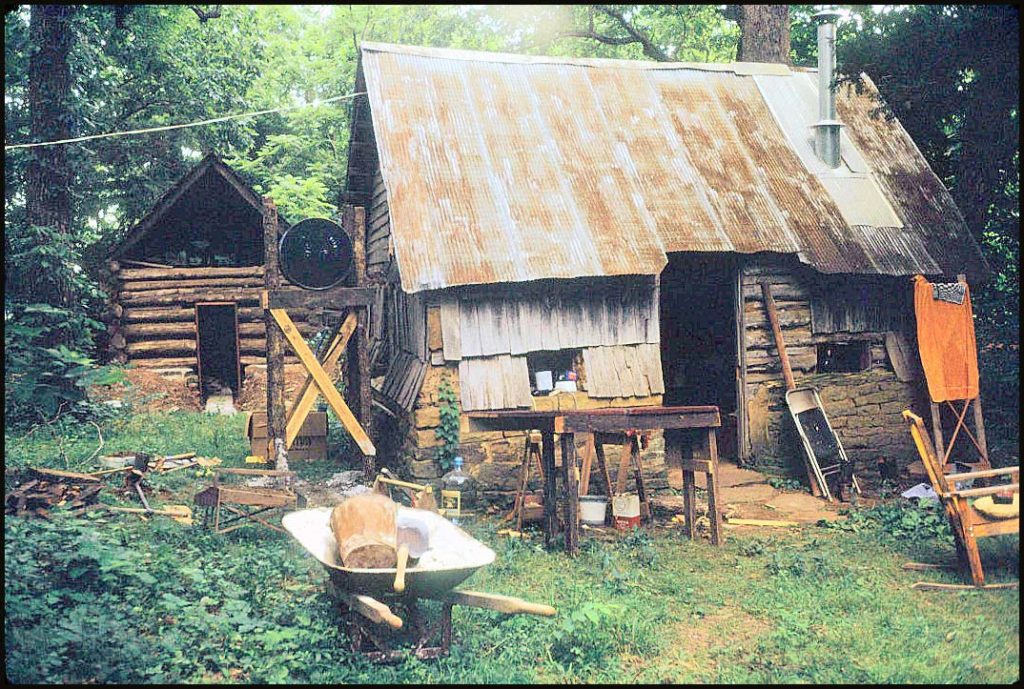
After I made some initial improvements to the barn, I started working on the small cabin that Lucas had vacated. I installed a 55-gallon barrel outside as a water tank for my kitchen sink water supply and put in a rustic counter top to prepare food on. I also built a wood-burning sauna as an alternative to a conventional bath or shower, which the cabin lacked. There was (and still is) an old well in the woods near where the sauna was. The hand pump on the well supplied water for the sauna. Every evening, I would stoke up the sauna, sweat myself clean, and rinse off afterwards with a large bucket of hand-drawn well water. Life was good. Many of my college girl friends would come up to visit when I lived there and sharing time in the hot steamy sauna was a unique way to warm things up.

During the summer I spent most of my extra time working on the barn project or the community garden. I built a small geodesic dome by taking an industrial arts course at the university so I would have access to the power tools I needed to fabricate the intricate angles out of clear redwood. The dome was intended to serve as a passive solar collector and a greenhouse. It was designed by my friend Bruce Schulte, a physics major, who did all the math calculations and helped cut the custom miters and finish the covering with clear Mylar.
A guy named James Lentz moved into Ward Pennington’s old house after Lucas left. Everybody knew him as Squeaker. Squeaker was a mason and he helped me chink the old logs on the barn with cement. He taught me enough about masonry that I was able to build a semi-circular stone wall on the front of the log barn to mount the geodesic half-dome. I also built a large round stone planter in front of the cabin, which is still there today.
As the barn renovation started to take shape, I became much more interested in it as an art project. I spent all I could afford on pouring a cement slab in and around the log barn to create a decent foundation for the completion of the project. I enlisted a friend from the food co-op to help me shoot some video footage to document the process. The video camera belonged to the University Art Department from what I can remember and it was probably one of the first portable video cameras ever available outside a television studio.
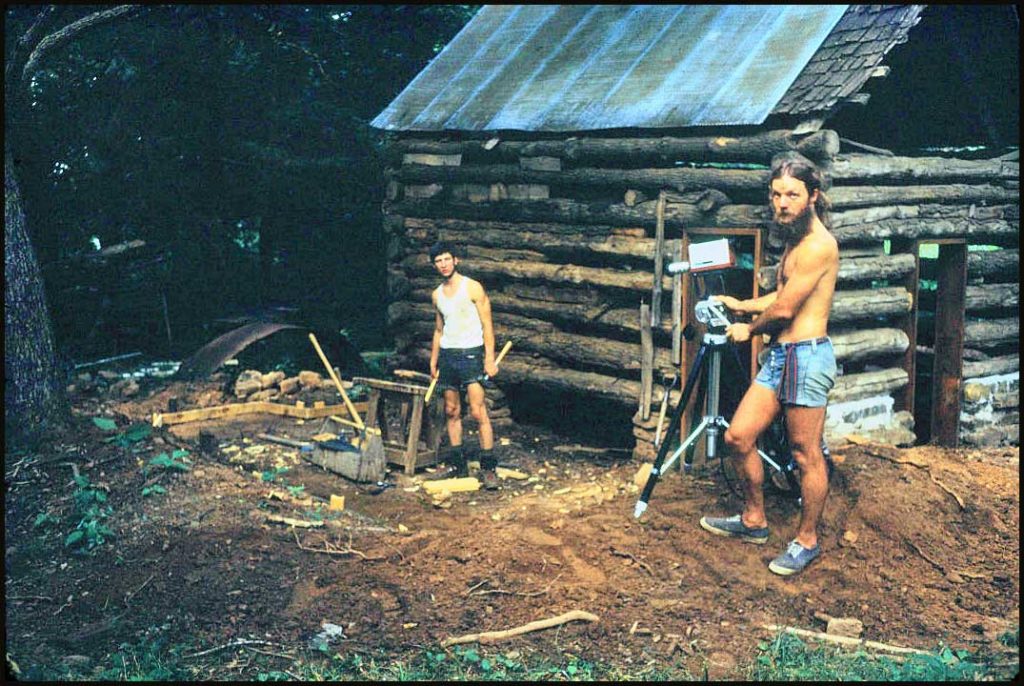
The early days of portable video cameras – shooting the process of building the forms for the slab foundation. (I really had no idea what I was doing.) That’s me on the left and a friend on the right.
As I did more work on the barn renovation, word got back to Ms. Markham about the progress I was making. When I would visit her in the big white house, she would always ask me about it and want to know how it was going. Mrs. Archer, Ms. Markham’s sister, also had learned what I was up to. She seemed a bit unsure of the improvements that were being made to the old cabins on the hill.
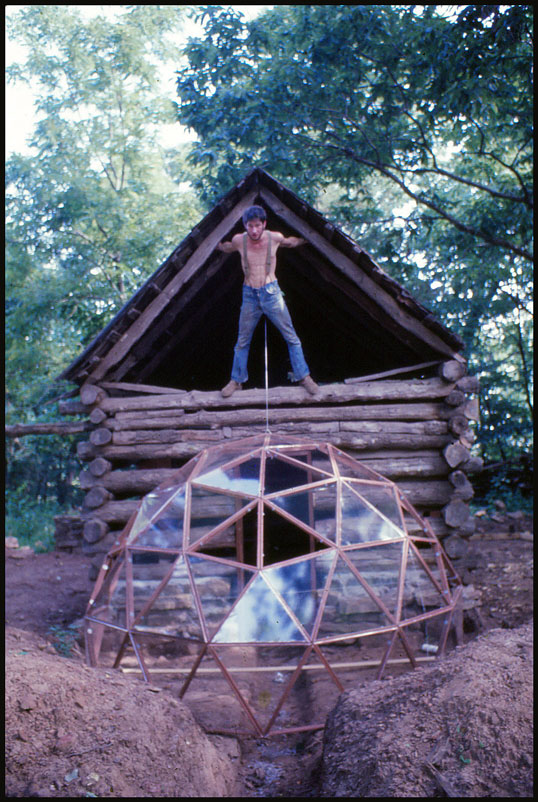
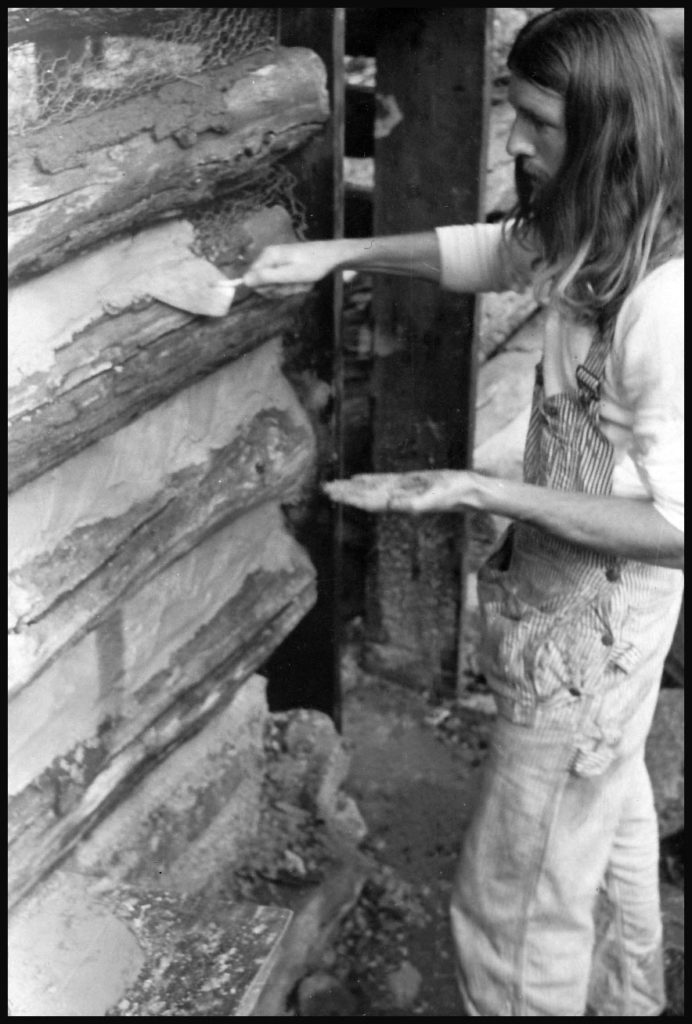
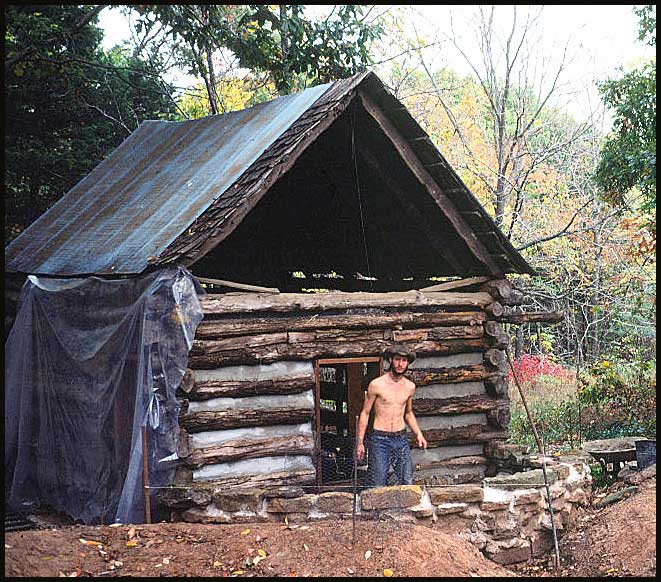
Although it was a delight to live in the little cabin, especially in the fall and early winter, it was increasingly difficult to live there and keep up with college classes in the middle of winter. Using an outhouse in cold weather is no fun at all and constantly freezing water was becoming a problem, as well. I spent a lot of time in Ms. Markham’s house helping her with various tasks and, as a result, she offered to let me stay in one of the spacious upstairs bedrooms in the winter. This was a huge relief: I no longer had to walk across the frozen pasture carrying groceries, I had hot water and a place to bathe, and I was able to use the kitchen. There were also a couple of fascinating people living in the big house in the extra bedrooms upstairs and it was nice to hang out with them in the warm house. The kitchen had a big, rare wood-burning cook stove that had a usable thermostat which was especially useful for cooking cakes. It was always a welcome place to be and there was almost always something good cooking in the stove.
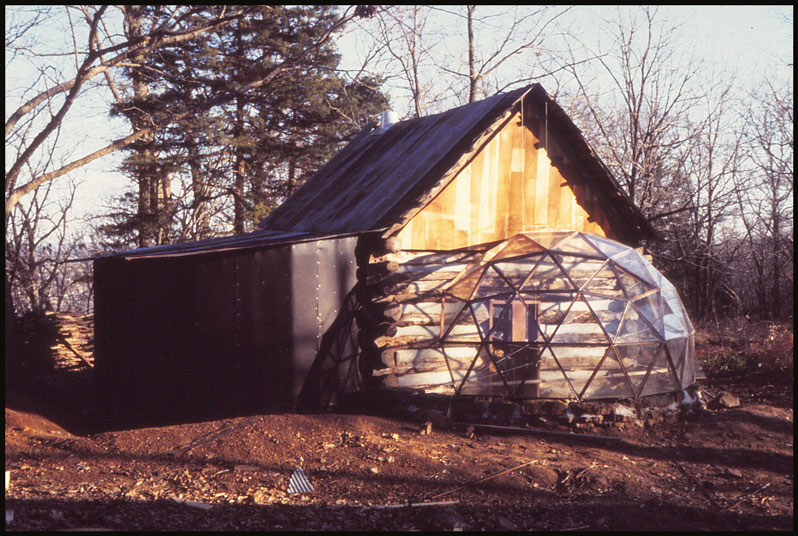
In the spring, I would return to living in the cabin and resume work on my projects. I put in a small garden in a clearing in the woods and continued to work on improving the old Pennington place. I had friends from Louisiana come up to visit and a few of them even rented cabins that became available for occupancy. Markham Hill had a reputation as a very special place and anyone who lived there during that time considered themselves very fortunate to have had the opportunity to spend time there. Markham Hill was a sanctuary where the back-to-the-land lifestyle could be experienced by those who would otherwise never have known such an existence.
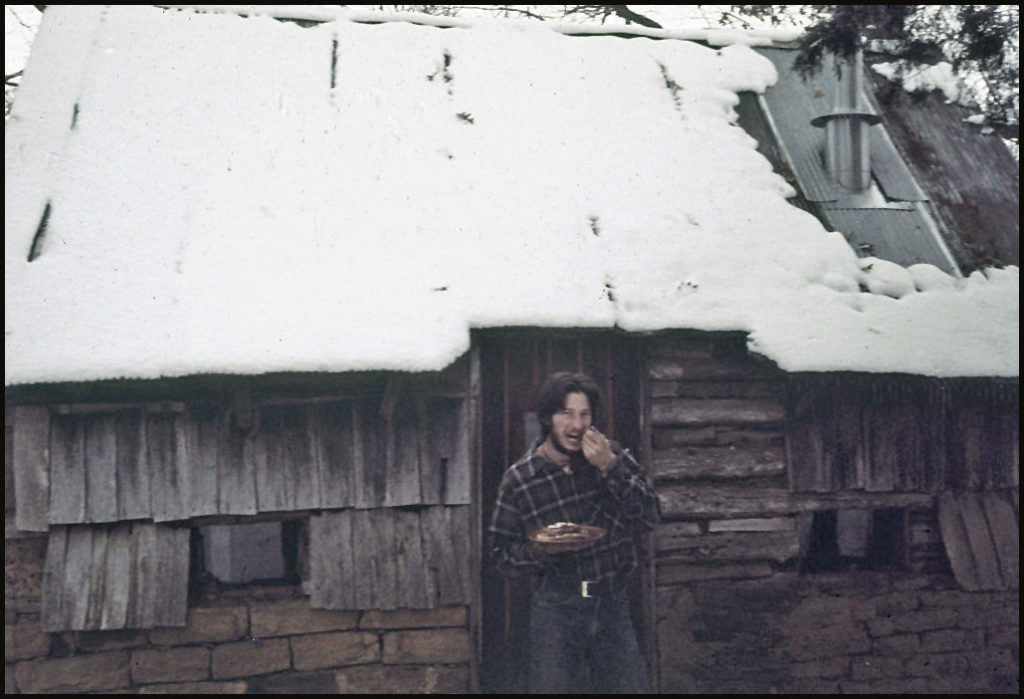
From time-to-time, I would drive Ms. Markham around at her request in her immaculate 1937 gray Bentley and help her out however I could. By 1975 or so, however, she was getting much weaker and was confined to her bed most of the time. The barn restoration had slackened because of a lack of funds and I didn’t feel comfortable asking her for additional backing because of her declining health. The project had fulfilled its purpose of providing me extra credits in sculpture toward my Bachelor of Arts degree, and my required courses were taking more of my time. I also had a new girlfriend who didn’t exactly fit in with the Markham Hill lifestyle. I moved into an apartment in town during my senior year to concentrate on passing the courses I needed to graduate. I continued to pay rent on the cabin so I could keep my projects intact and resume work after I graduated. Unfortunately, Ms. Markham died in March of 1976, a couple of months before I finished college.
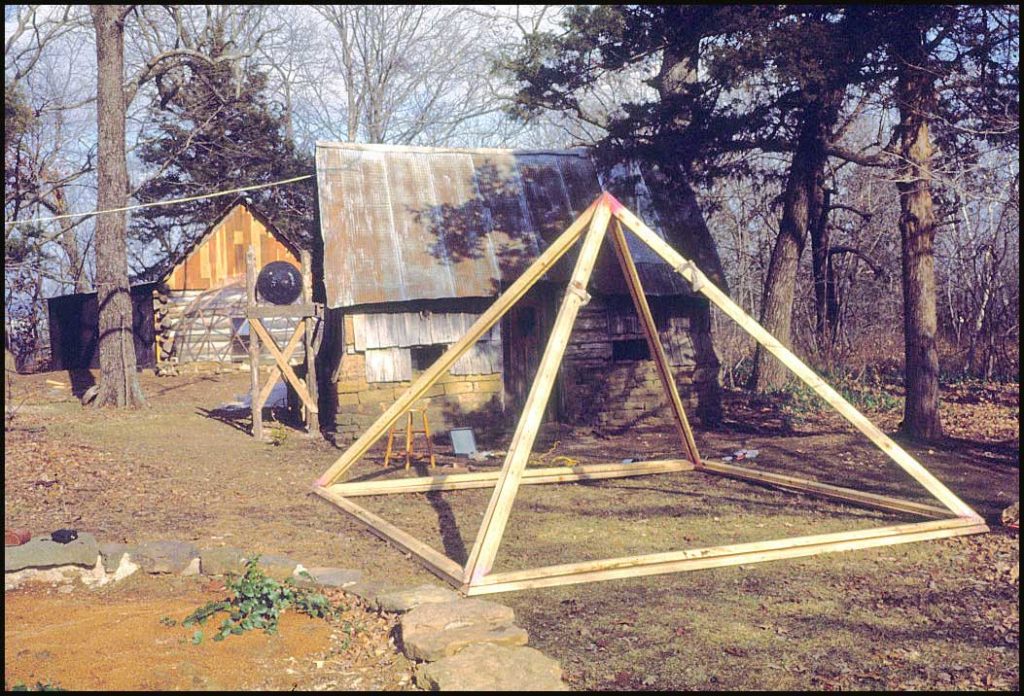
During my time on Markham Hill I met many interesting people who were residents or were just passing though. Living there was the best of times and I will always be grateful to Ms. Markham for her generosity and her willingness to keep her land open for people to enjoy. I know she would be horrified to know what has happened to her aspirations for the property and the sale and impending developments to the estate. Markham Hill is a sanctuary and a sacred place. It is my hope—and I know the hope of countless others—that it remains the way Ms. Markham intended.
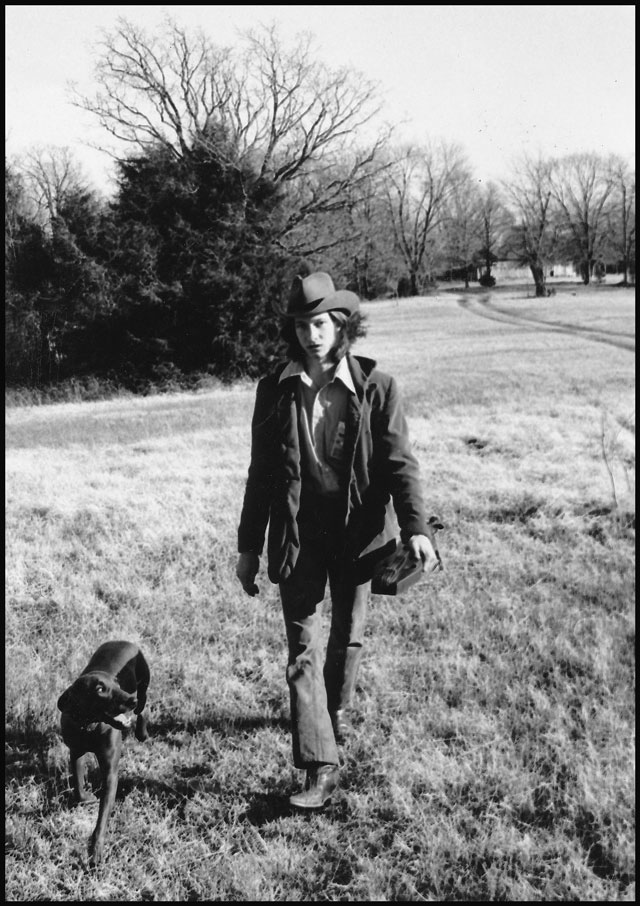
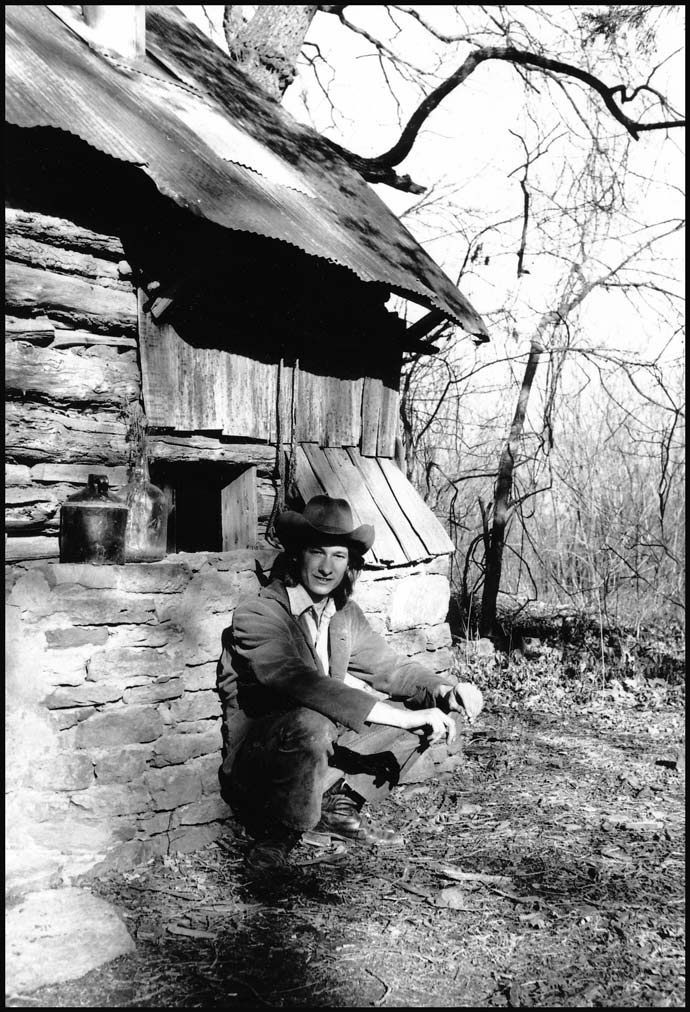
Copyright © 2019 by Micheal T. Parks
All photos courtesy Micheal T. Parks
All rights reserved.